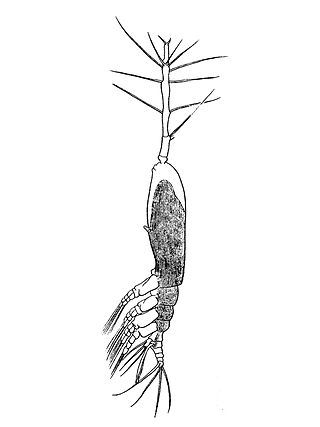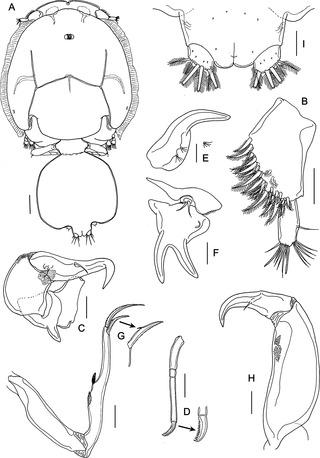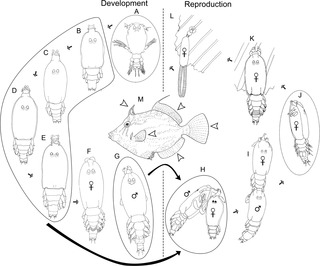
Copepods are a group of small crustaceans found in nearly every freshwater and saltwater habitat. Some species are planktonic, some are benthic, a number of species have parasitic phases, and some continental species may live in limnoterrestrial habitats and other wet terrestrial places, such as swamps, under leaf fall in wet forests, bogs, springs, ephemeral ponds, puddles, damp moss, or water-filled recesses of plants (phytotelmata) such as bromeliads and pitcher plants. Many live underground in marine and freshwater caves, sinkholes, or stream beds. Copepods are sometimes used as biodiversity indicators.

The Pacific viperfish, Chauliodus macouni, is a predatory deep-sea fish found in the North Pacific. It is reported as being either mesopelagic or bathypelagic, with diel vertical migration to shallower waters. The Pacific viperfish is one of the nine different species that belong to the genus Chauliodus, the viperfish. The Pacific viperfish tend to be the largest of the species, typically reaching lengths of up to 1 foot and are considered an example of deep-sea gigantism. The length-weight relationship of the pacific viperfish varies with sex with females tending to be longer and heavier than males.

Siphonostomatoida is an order of copepods, containing around 75% of all the copepods that parasitise fishes. Their success has been linked to their possession of siphon-like mandibles and of a "frontal filament" to aid attachment to their hosts. Most are marine, but a few live in fresh water. There are 40 recognised families:

Monstrilloida is an order of copepods with a cosmopolitan distribution in the world's oceans. The order contains a single family, Monstrillidae. The name of the first ever described genus Monstrilla is derived from latin, meaning "tiny monster", because the lack of usual diagnostic features of copepods puzzled early taxonomists.
Bomolochidae is a family of copepods parasitic on marine fishes. Most species parasitize the gills of fish, but some species live in the nostrils or on the eyes of their hosts. The family contains just over 150 species from the following genera:

Caligus is a genus of sea lice in the family Caligidae. The species are parasites of marine fishes and could be vectors of viruses. As of 2017, the World Register of Marine Species includes the following species:

Stephanolepis cirrhifer, commonly known as the thread-sail filefish, is a species of marine fish in the family Monacanthidae. It is found in the western Pacific, in an area that ranges from northern Japan to the East China Sea, to Korea. Other common names for the fish include kawahagi (カワハギ,皮剥) (Japanese) and “쥐치” "Jwi-chi" (Korean). The fish grows to a maximum length of about 12 inches, and consumes both plant material and small marine organisms like skeleton shrimp. S. cirrhifer is host of the parasite Peniculus minuticaudae. Some minor genetic differentiation between S. cirrhifer born in the wild and those bred in a hatchery for consumer use has been shown. The fish is edible and sold commercially for culinary purposes in many Asian countries.

Lernaeopodidae is a family of parasitic copepods. The females are typically large and fleshy, and attach to the host permanently using a plug made of chitin called the bulla. The males cling on to the females using their antennae. They parasitize both marine and freshwater fish. Some lernaeopodids, including Clavella and Salmincola, can have negative impacts on fish in aquaculture.
Pennella is a genus of large copepods which are common parasites of large pelagic fishes. They begin their life cycle as a series of free-swimming planktonic larvae. The females metamorphose into a parasitic stage when they attach to a host and enter into its skin. The males are free swimming. Due to their large size and mesoparasitic life history there have been a number of studies of Pennella, the members of which are among the largest of the parasitic Copepoda. All species are found as adults buried into the flesh of marine bony fish, except for a single species, Pennella balaenopterae which can be found in the muscles and blubber of cetaceans and occasionally other marine mammals, and is the largest species of copepod.

Lepeophtheirus is a genus of sea louse. The best-known species is L. salmonis, the salmon louse. Other species include L. pectoralis, which uses flatfish as its host, particularly the European flounder, and is also the type species of the genus Lepeophtheirus.

Eudactylina is a genus of copepods. They parasitise elasmobranch fishes.
Peniculisa is a genus of marine parasitic copepods in the family Pennellidae.

Lepeophtheirus elegans is a species of sea lice.
Cardiodectes is a genus of copepods in the family Pennellidae. Species are parasites of fish.

Protosarcotretes is a genus of marine copepods in the family Pennellidae. Its type-species is Protosarcotretes nishikawai. This genus exhibits the most plesiomorphic states in the first to fourth legs of pennellids, and is differentiated from two closely related pennellid genera Sarcotretes and Lernaeenicus by the morphology of the oral appendages.

Peniculus is a genus of marine copepods in the family Pennellidae. They occur worldwide and typically parasitize coastal or epipelagic fish, with the exception of Peniculus hokutoae that was found parasitizing a mesopelagic myctophid, Symbolophorus evermanni.

Peniculus minuticaudae is a species of parasitic pennellid copepod. It is known from the northeast Pacific Ocean. It was originally described in 1956, redescribed in 2012, and its complete life cycle has been elucidated on the cultured threadsail filefish, Stephanolepis cirrhifer in 2013.

Peniculus hokutoae is a species of parasitic pennellid copepod. It was described in 2018 from a single female. The type-host is the myctophid fish Symbolophorus evermanni and the type-locality is off Japan. The Japanese name of this species is hokuto-kozutsu-hijikimushi.

Symbolophorus evermanni is a species of fish in the family Myctophidae. It is widely distributed in the Indian and Pacific Oceans. The specific name evermanni honors ichthyologist Barton Warren Evermann. It is also known as Evermann's lanternfish or Evermann's lantern fish.















